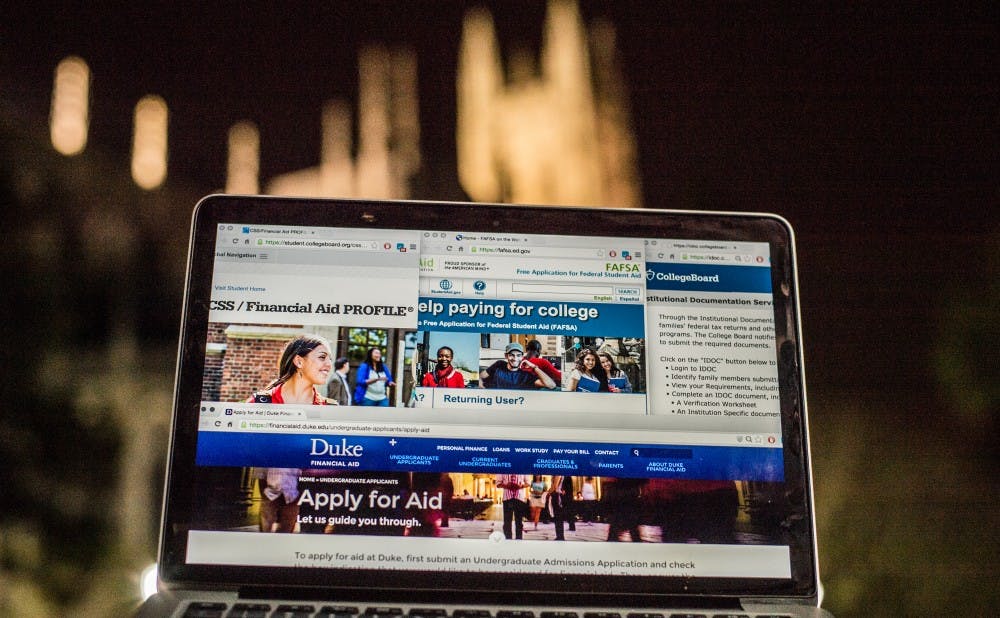In the wake of Stanford University's recent modifications to its financial aid policy, Duke administrators cite its endowment as a justification for not keeping up.
In March, at the conclusion of its admissions process for the Class of 2019, Stanford announced an expansion of its financial aid policies that will cover tuition costs for families with an annual income less than $125,000. This expands the policy from the previous threshold of $100,000.
Under the new policy, households with an annual income less than $65,000 are not expected to contribute toward the cost of attendance. Stanford previously used the $60,000 barrier to determine when it could offer zero parental contribution—the same mark Duke has used for seven years and plans to maintain moving forward.
"Stanford's policy is more generous than Duke can afford to be, given their endowment compared to ours," said Alison Rabil, assistant vice provost and director of financial aid at Duke.
Duke's endowment reached a record high of $7 billion at the end of the 2013 fiscal year. In the same year, Stanford's was more than three times as large, reporting in at $21.4 billion.
The release of Stanford’s financial aid increase was announced amid national conversation regarding the rising cost of college tuition at both private and public colleges. In addition to offering to cover full tuition for lower income families, the university also extended eligibility for financial aid to higher income families.
“Families with incomes at higher levels (typically up to $225,000) may also qualify for assistance, especially if more than one family member is enrolled in college,” reads an update on Stanford’s official financial aid website.
Duke announced its decision to eliminate contributions from families that earn less than $60,000 annually during the 2008-09 academic year—the same time that Stanford implemented the same standard.
“Duke is not that far behind [Stanford]," Rabil said. "Many families earning in a similar income range have quite substantial grant aid from Duke. We are one of the few need blind schools in the nation and have a very strong commitment to make it possible for students who are admitted to Duke to attend.”
Rabil noted that Duke has made efforts to expand its current financial aid programs to make the University more accessible. Among them is expansion of financial aid programs for current Duke students to make opportunities more accessible to students with all backgrounds.
“We have expanded our efforts this year to support enrolled students. Our Office of Access and Outreach has many programs and opportunities for students who are in need of non-academic support, community and direction while learning to navigate Duke,” she said.
As college becomes more difficult to pay for, top universities nationwide are examining ways to provide financial aid to broader populations.
Parents of undergraduate students at Harvard University who make less than $65,000 per year are not expected to contribute to their child's education, and families in the $65,000-$150,000 range are expected to contribute less than 10 percent of their annual income. Similarly, families of Yale undergraduates with an annual income of $65,000 enjoy free tuition education. In 2001, Princeton University became the first university to implement a program that gives recipients of financial aid monetary grant packages instead of student loans.
The efforts to reduce the burden of tuition by elite universities have received wide national support, but doubts remain about the percentage of students that will benefit.
“I’m very interested in understanding how many kids this policy will actually help,” said junior Abhi Sanka, executive vice president of Duke Student Government. “Duke and Stanford are so not socioeconomically diverse that the policy change by Stanford probably helps Stanford’s image—given the political climate of college costs—more than the number of students the policy could potentially help.”
Get The Chronicle straight to your inbox
Signup for our weekly newsletter. Cancel at any time.

